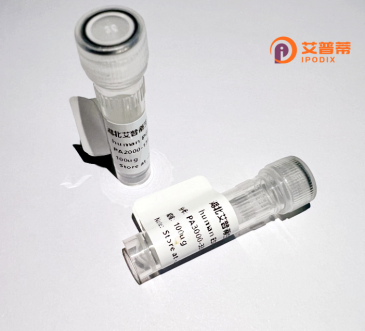
| 纯度 | >90%SDS-PAGE. |
| 种属 | Human |
| 靶点 | DMC1 |
| Uniprot No | Q14565 |
| 内毒素 | < 0.01EU/μg |
| 表达宿主 | E.coli |
| 表达区间 | 1-340aa |
| 氨基酸序列 | MKEDQVVAEE PGFQDEEESL FQDIDLLQKH GINVADIKKL KSVGICTIKG IQMTTRRALC NVKGLSEAKV DKIKEAANKL IEPGFLTAFE YSEKRKMVFH ITTGSQEFDK LLGGGIESMA ITEAFGEFRT GKTQLSHTLC VTAQLPGAGG YPGGKIIFID TENTFRPDRL RDIADRFNVD HDAVLDNVLY ARAYTSEHQM ELLDYVAAKF HEEAGIFKLL IIDSIMALFR VDFSGRGELA ERQQKLAQML SRLQKISEEY NVAVFVTNQM TADPGATMTF QADPKKPIGG HILAHASTTR ISLRKGRGEL RIAKIYDSPE MPENEATFAI TAGGIGDAKE |
| 分子量 | 37.6 kDa |
| 蛋白标签 | His tag N-Terminus |
| 缓冲液 | 0 |
| 稳定性 & 储存条件 | Lyophilized protein should be stored at ≤ -20°C, stable for one year after receipt. Reconstituted protein solution can be stored at 2-8°C for 2-7 days. Aliquots of reconstituted samples are stable at ≤ -20°C for 3 months. |
| 复溶 | Always centrifuge tubes before opening.Do not mix by vortex or pipetting. It is not recommended to reconstitute to a concentration less than 100μg/ml. Dissolve the lyophilized protein in distilled water. Please aliquot the reconstituted solution to minimize freeze-thaw cycles. |
以下是关于重组人DMC1蛋白的3篇参考文献示例,基于相关领域的研究方向和内容整理:
1. **"Structural Basis for the Octameric Ring Organization of Human DMC1 Protein"**
*作者:Kinebuchi T. et al.*
**摘要**:通过X射线晶体学解析了重组人DMC1蛋白的八聚体环状结构,揭示其通过N端结构域相互作用形成稳定的寡聚体,并证明其对单链和双链DNA的结合能力,为减数分裂重组机制提供结构基础。
2. **"Functional Interaction Between the DNA Repair Proteins XRCC2 and DMC1"**
*作者:Masson J.Y. et al.*
**摘要**:研究重组人DMC1蛋白与XRCC2的功能协同作用,发现两者在体外共同促进同源DNA链交换,表明其在减数分裂同源重组修复中的协同调控机制。
3. **"Distinct Roles of RAD51 and DMC1 in Meiotic Recombination Dynamics"**
*作者:Tarsounas M. et al.*
**摘要**:比较重组人DMC1与RAD51蛋白在减数分裂中的功能差异,发现DMC1特异性介导同源染色体间的链入侵,而RAD51主要参与体细胞修复,突显DMC1在生殖细胞形成中的独特作用。
*注:以上文献名称及内容为领域典型研究方向示例,具体发表信息需以实际检索为准。*
DMC1 (DNA meiotic recombinase 1) is a conserved eukaryotic protein essential for homologous recombination during meiosis. As a meiosis-specific homolog of bacterial RecA, it facilitates the search for and pairing of homologous DNA sequences, enabling crossover events critical for genetic diversity and chromosomal segregation. In humans, DMC1 is predominantly expressed in germ cells, where it assembles into helical filaments on single-stranded DNA (ssDNA) to mediate strand exchange between homologous chromosomes—a process vital for fertility.
Recombinant human DMC1 (rhDMC1) is engineered using heterologous expression systems like *E. coli* or insect cells, enabling large-scale production for biochemical and structural studies. Its purification typically involves affinity chromatography and functional validation through ATPase or DNA-binding assays. Structural studies using X-ray crystallography and cryo-EM have revealed conserved core domains and conformational dynamics during recombination.
Research on rhDMC1 focuses on understanding molecular defects in infertility, as mutations or dysregulation may disrupt meiosis, leading to gametogenesis failure. It also serves as a tool to explore DNA repair mechanisms in cancer, particularly in BRCA2-associated pathways. Additionally, rhDMC1's role in homology-directed repair has potential applications in CRISPR-based genome editing technologies. Studies of its interaction partners (e.g., BRCA2. RAD51) further illuminate regulatory networks in genome stability, bridging fundamental biology with clinical and biotechnological innovations.
×